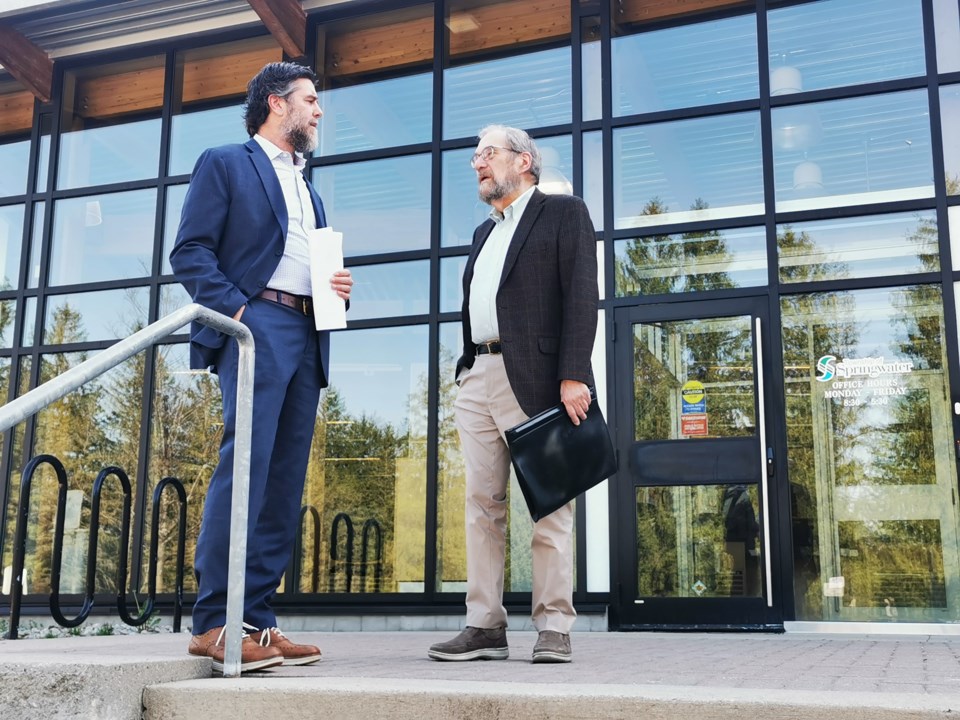Regardless of how much or how little individual Springwater Township councillors knew about ward boundary reviews going in, an introductory primer provided all of them with the fundamentals they’ll need to move the process forward.
At a special session of council Wednesday, Watson and Associates Economists provided council with an overview of what ward boundary reviews are and why they’re important.
“We need to understand how growth is occurring, where it’s occurring in your township, from ward-to-ward, and also where it’s going to occur," Jack Ammendolia, managing partner at Watson and Associates, said during his introduction to council.
“Because we also don’t want to do a ward boundary that lasts for one election," he added. “Ideally, the intention is to last for at least a couple of elections, trying to recognize again, how the municipality is going to grow and where it’s going to grow.”
Ammendolia was joined by Dr. Robert Williams, a public affairs consultant and municipal electoral systems expert who has conducted or advised on ward boundary and electoral system reviews in 30 Ontario municipalities.
Ammendolia started by asking members of council to consider this question: How does the present electoral arrangement for the Township of Springwater measure up?
“Big question, right? But that‘s ultimately what we’re trying to understand in this first phase," he said. "How does the system currently work?”
Ammendolia also wants councillors to consider if the current boundaries deliver fair representation, in terms of accessibility (ie. how easily can residents communicate with elected officials) and workload (ie. are councillors spread thin attending to too many priorities).
He also wants them to put some thought into what they want to see as an outcome.
“This is entirely a council decision,” Ammendolia said. “Consider what type of things you need, or want, to see to make those decisions.”
The ward boundary review, which cost $50,000, was approved in the 2024 budget.
Springwater’s current ward boundaries have been in place since 2014, but with the growth in Ward 4 and the projected growth in Ward 5, a ward boundary review was required prior to the 2026 municipal election.
The justification report that accompanied the budget request said the review should take place in 2024 to ensure there is adequate public consultation and ample time to meet legislative requirements.
The review should take about a year to complete, which would ensure the project, council's decision and any appeals are dealt with prior to the Dec. 31, 2025 legislative deadline.
According to Williams, municipal councils don’t have many legislative requirements to meet.
“The Municipal Act authorizes a lower-tier municipality, like Springwater, to do basically three things,” he said. “It can change the size of its council as long as there are a minimum of five members. One of those members has to be the head of council.”
Williams said that decision cannot be appealed.
“Second is how the council is elected, except for the head of council, who must be elected by general vote or an at-large system,” he added.
Other members can be elected by an at-large system or by wards, or by some combination of the two.
That decision cannot be appealed, either.
The last thing council can do is divide or re-divide the municipality into wards or dissolve the existing wards.
“A bylaw under that revision is open to appeal,” Williams said. “Any member of the community, r council also I suppose, could appeal that bylaw and the Ontario Land Tribunal would be required to examine the bylaw to see if it can stand.
“Our goal is to make sure no appeal is needed,” he added.
Any appeals must be fully resolved by the Dec. 31, 2025 deadline in order for the ward boundary changes to take affect for the 2026 municipal election, if that’s the direction council wishes to go.
According to Ammendolia, wards should have relatively equal populations. It’s generally accepted that variations of up to 25 per cent above or below the average size are considered reasonable and are consistent with legislated federal distribution provisions, precedents and past decisions and best practices in municipalities.
In Springwater, there are currently 17,506 eligible voters in the township, including 2,973 in Ward 1, 3,204 in Ward 2, 3,674 in Ward 3, 4,357 in Ward 4, and 3,298 in Ward 5.
Those numbers are anticipated to change dramatically over the next 20 years as the township's population is expected to grow to almost 50,000, according to another Watson and Associates report called Long-Term Fiscal Impact Assessment of Growth, 2021-2041.
An updated version of the township's transportation master plan, which was presented at the March 6 council meeting, says about 60 per cent of those 50,000 — upward of 30,000 people — will be living in Midhurst, which will be the township's growth centre and home to the majority of the township’s residents.
The report said Elmvale is projected to grow to about 6,000 residents. Hillsdale and Centre Vespra will have about 4,000 residents each, Snow Valley will max out around 3,500, Anten Mills and Minesing will reach about 1,000 residents each, and Phelpston will grow to about 500 residents.
Over the next couple of months, Watson and Associates will interview members of council, collect 'core review themes' and key considerations, and prepare background documents.
Over the summer, the consultants will take a closer look at the collected information, evaluate existing ward boundaries and explore alternatives.
In the fall or winter, they will engage community and stakeholders, present alternative options and deliver recommendations to council.

